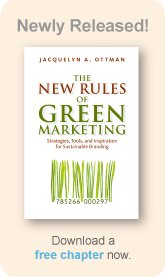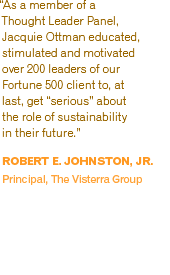Quality Trumps Altruism for Today’s Green Consumers
By Jacquie Ottman
O'Dwyer's Magazine, February 2011
Green has gone mainstream. Products that formerly caught the interest of only a fringe group of consumers have now become a $290 billion dollar industry.
Of course, products claiming to be environmentally friendly have been around since the 1970s - you may remember those phosphate-free laundry detergents that left clothes dingy, or compact fluorescent bulbs that cast a green haze. Thanks to quality improvements and savvy marketing, green products in recent years have rivaled - and are even beginning to surpass - "brown" counterparts in quality and ubiquity. As a result, today's greener products are no longer sold just in health food stores, but in major retail outlets nationwide.
Indeed, "thinking green" is unleashing a host of creative innovations for products around the home. Take diapers. The standard greener alternative to the landfill-clogging disposable diaper used to be cloth or so-called "biodegradable" replacements. Now, it's "Ultra"-thin Pampers, which take up less landfill space. In the not-too-distant future, the flushable "G" diaper - whose innovative two-part construction allows the inner lining to be flushed, with the attractively designed outerpants to be used over and over - may very well become the gold standard in green baby care. Laundry detergent has gone through a number of green iterations too. Super-concentrated detergents are now making way for even more concentrated pump sprays, which might also give way to newer innovations currently under development.
Underscore primary benefits
Each new green development ups the ante for a green standard, changing green consumers' perceptions of what's acceptable - and gives marketers exciting primary benefits to communicate, beyond yesterday's now clichéd "Save the Planet" pitches.
Today's savvy marketers now promote the added value their products provide: better health, superior performance, good taste, cost-effectiveness, and even status. Emphasizing such primary benefits is critical to winning over today's broad swath of mainstream consumers.
Indeed, the target demographic for green marketing is not the "educated women, 30-49, with children" of yesteryear, but one of many possible segments of a dynamic consumer base that now comprises 83 percent of all U.S. adults.
Seven rules of good green marketing
Since both the products and the consumers have changed, it makes sense that the rules of green marketing itself must change along with them. Below are seven new rules of green marketing, as discussed in my book "The New Rules of Green Marketing: Strategies, Tools, and Inspiration for Sustainable Branding."
Save me! Yesterday, green marketing focused on consumers' desire to "save the planet." Today, consumers buy greener brands to help protect their health, save money, or because they simply work better. That's why products such as organic food and clothing, natural personal care and pet care, and energy-efficient products are leading the way in sales. So, scrap the images of planets! Bag the daisies! Nix the babies! For better or for worse, today's green marketing appeals to consumers' less altruistic impulses.
Businesses are philosophies. It used to be that companies were what they made. International Business Machines. General Foods. General Motors. Now, businesses and brands are what they stand for. Method's innovative line of household cleaning and personal care products rests upon a multi-pronged product development platform that balances design, fragrance, efficacy, and environmental and personal safety to provide positive experiences for the individual and the environment. Starbucks demonstrated that a global company serving 50 million per day can turn a proactive approach to sustainable sourcing and operations into a strategic and profitable part of its brand. Timberland's attention to quality, passion for the environment and commitment to transparency has helped earn a strong customer following willing to pay its premium.
The brands consumers buy and trust today educate and engage them in meaningful conversation through a variety of media, especially via websites and online social networks. Talking "at" consumers through traditional media and paid advertising can't build loyalty among empowered consumers in a connected world. That's the magic behind Method's "People Against Dirty" interactive social media campaign, and why Whole Foods has 1.9 million Twitter followers and counting.
Green consumers are strongly influenced by recommendation, be it from friends, family, or trusted third parties. With rampant cynicism about traditional forms of advertising and a backlash in place against perceived greenwashing, savvy marketers leverage purchase influencers and third parties like NGOs and especially eco-labelers.
According to 2009 research from Nielsen, 90 percent of consumers trust recommendations from people they know significantly more than ads on television or in newspapers. The Internet is one of the green consumer's most powerful tools. Websites like GoodGuide.com - which allows shoppers to access the health, social and environmental track records of over 70,000 food, toys, personal care and household products - and Care2.com, the largest online empowerment community of green consumers, with 14 million members - allow the kind of informed decision making that is key to green consumption.
Green consumers trust brands that tell all. BP, ExxonMobil, and SIGG learned this the hard way. It's no longer enough to have a well-known name. Today's brands become trusted by practicing "radical transparency," disclosing the good and the bad.
One especially laudable example, Patagonia's Footprint Chronicles microsite lets visitors trace the environmental impacts of ten Patagonia products from design through delivery, including components and where they come from, innovations used to reduce impacts on the environment, and what the company thinks it can improve on. Patagonia encourages customer comments, a practice that builds loyalty. As the company learns more, it applies this knowledge to its broad spectrum of products.
Authenticity. It's not enough to slap on a recycling logo or make a biodegradability claim. Brands viewed as the most genuine integrate relevant sustainability benefits into their products. That's why HSBC and Stonyfield Farm aim to reduce the carbon impacts of their operations, giving each company the fodder for highly relevant green marketing messages in the process.
Keep it simple. Plato was an environmentalist:
"Simplicity is elegance." Today's consumers are cutting out the needless purchases, and getting rid of the gadgets and gizmos that don't add value to their lives. That's why they are migrating to brands that help express these values. It's just that simple.



 ShareThis
ShareThis
By Jacquelyn A. Ottman, founder and principal, J. Ottman Consulting, Inc. expert adviser on green marketing to Fortune 500 companies and the U.S. government. She is the author of three books, and the newly released, The New Rules of Green Marketing: Strategies, Tools, and Inspiration for Sustainable Branding (Berrett-Koehler, February 2011, 252 pp.)
Contact her by email
Follow her on Twitter
Connect to her on Linkedin
Read her blog
Note: This article was first published in O'Dwyer's Magazine.


